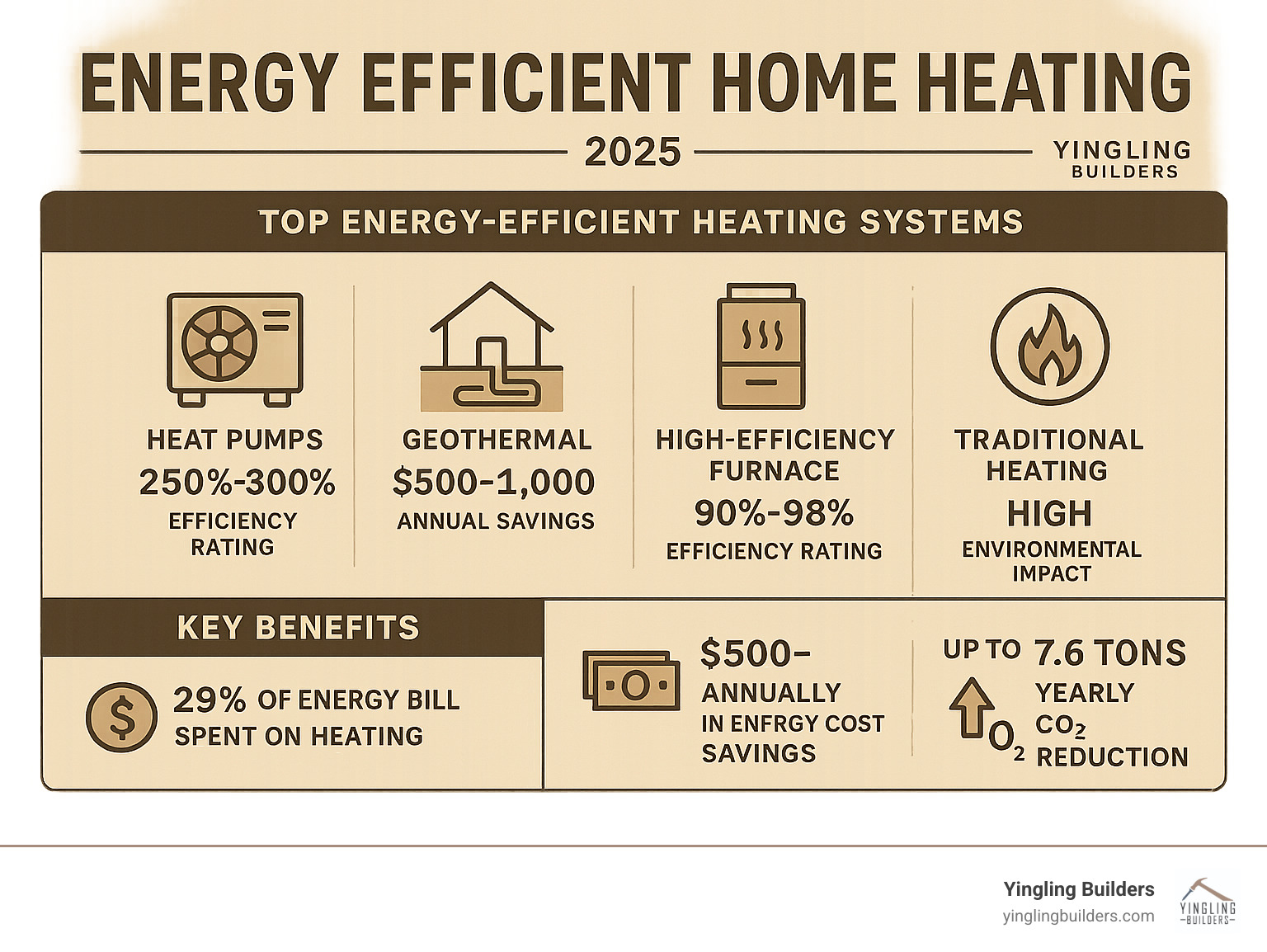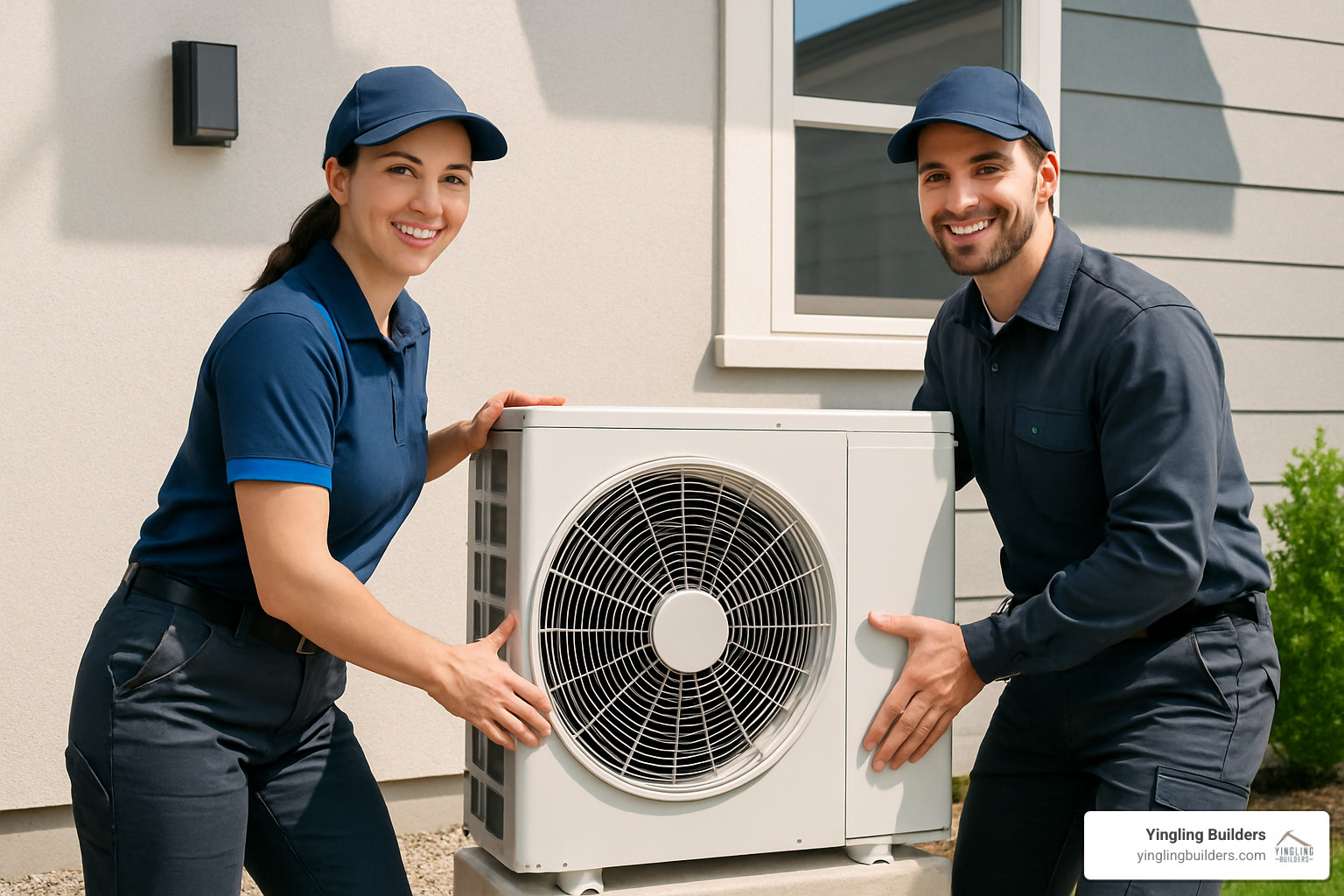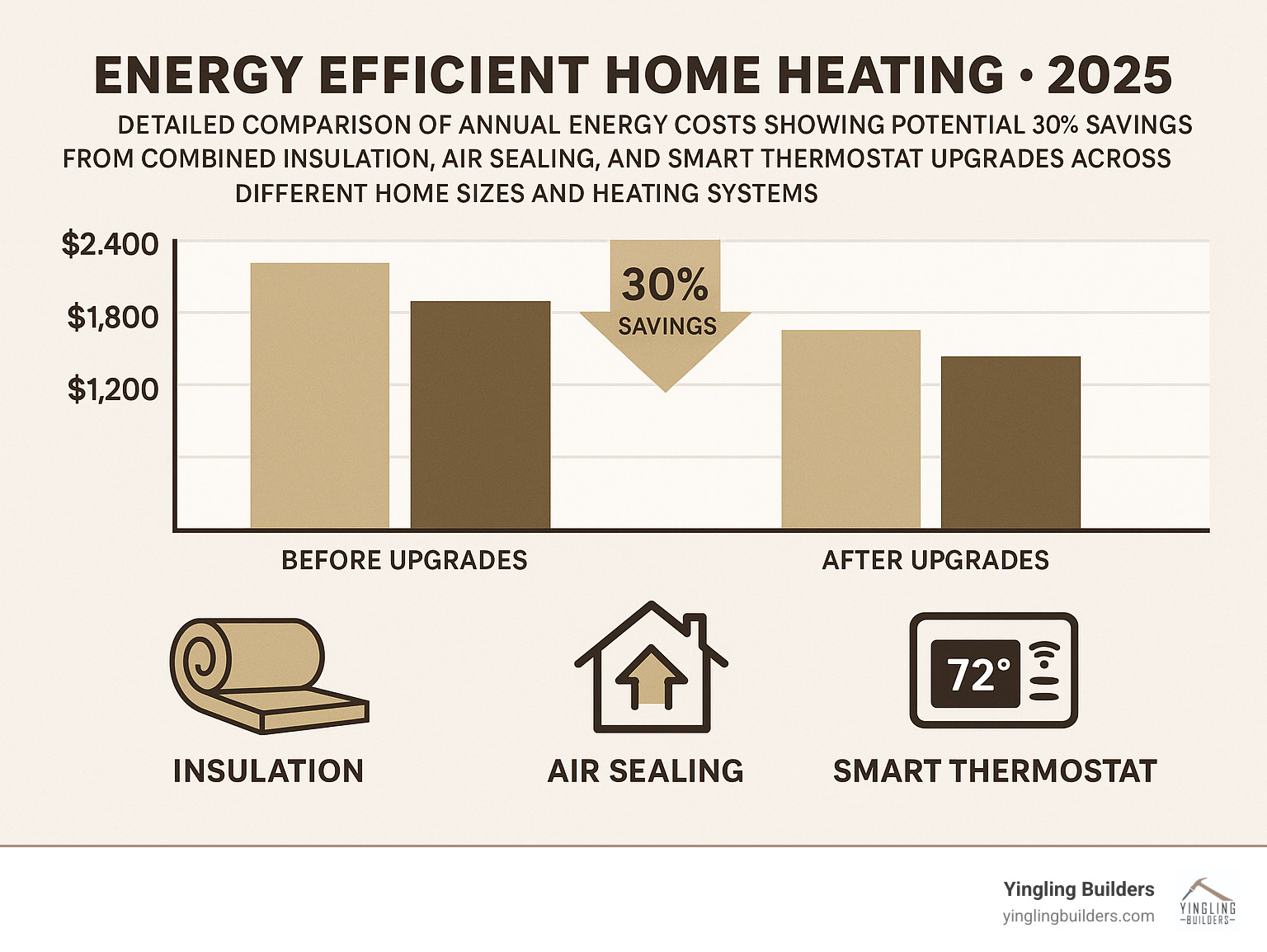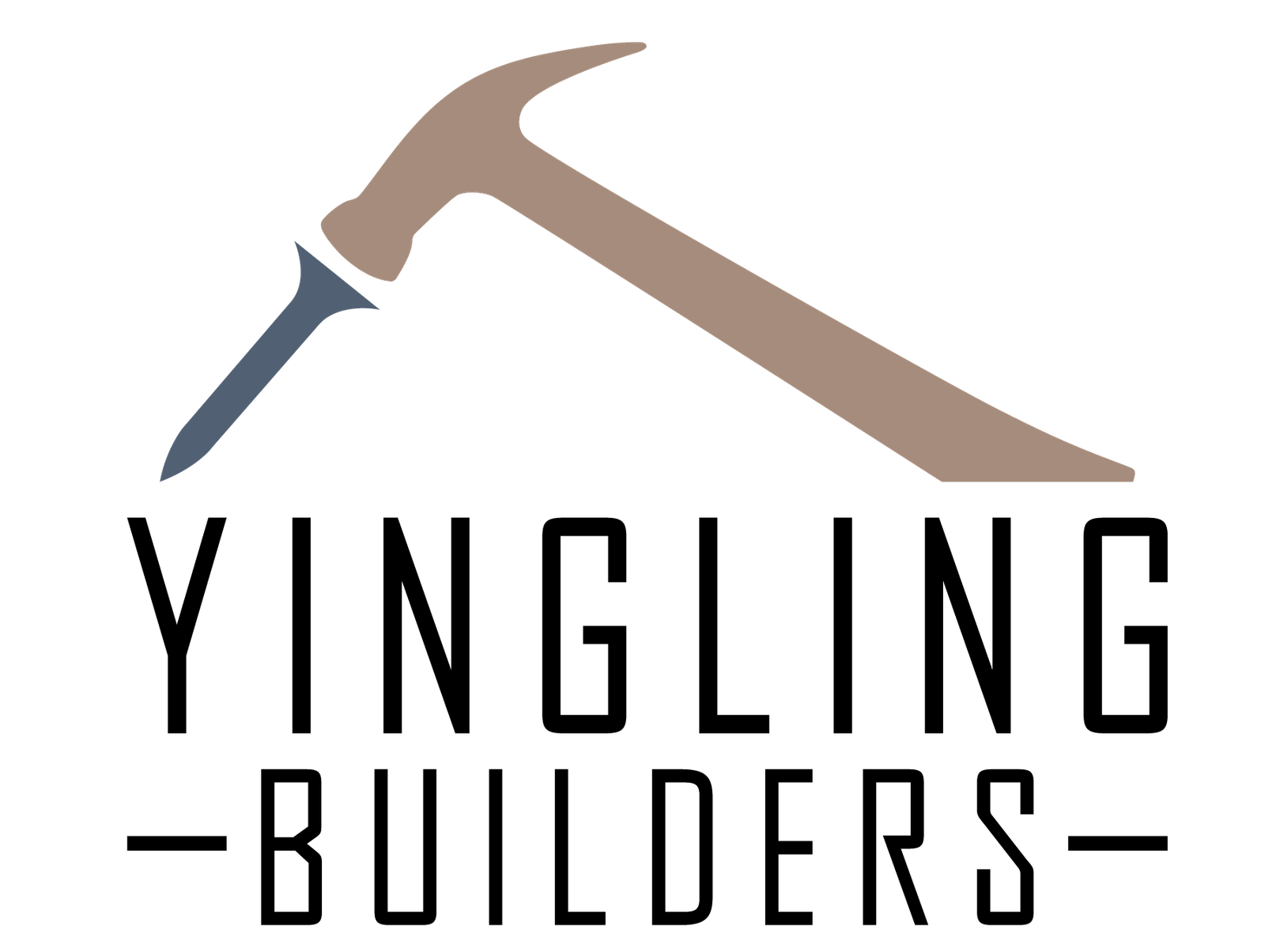Energy Efficient Heating: Your Smartest Home Investment
Energy efficient home heating systems can transform your home’s comfort while slashing your utility bills. Here’s what you need to know:
Top Energy Efficient Heating Options:
- Heat Pumps – Cut electricity use by 50-75% compared to electric resistance heating
- Geothermal Systems – Reduce energy use by 30-60% with ground-source technology
- High-Efficiency Furnaces – Achieve 90-98% AFUE ratings vs. older 56% models
- Condensing Boilers – Extract maximum heat from fuel with advanced technology
Key Benefits:
- Heating accounts for 29% of your utility bill – the largest energy expense
- Modern systems can save $500+ annually on energy costs
- Federal tax credits up to $3,200 per year available through 2032
- Reduce carbon footprint by up to 7.6 tons of CO annually
The reality is simple: your heating system works harder and costs more than any other system in your home. Whether you’re building new or upgrading existing equipment, choosing the right energy efficient technology pays dividends for decades.
I’m Seth Yingling, and over my 15+ years in construction and home building, I’ve seen how energy efficient home heating systems transform both comfort and monthly expenses for homeowners. Through my work with Yingling Builders and specializing in custom homes, I’ve guided countless families toward heating solutions that deliver long-term value and year-round comfort.

Heating Efficiency 101: Why It Matters
Understanding heating efficiency isn’t just about saving money – though that’s certainly important when heating represents nearly half of your home’s energy consumption. It’s about making smart decisions that impact your family’s comfort, your environmental footprint, and your long-term financial well-being.
When we talk about efficiency, we’re measuring how much useful heat you get from the energy you pay for. An old boiler operating at 56% efficiency means 44% of your fuel dollars literally go up the chimney. Compare that to a modern geothermal system that can deliver 4 times more heat energy than the electricity it consumes – sometimes reaching 400-600% efficiency.
The difference is staggering. We’ve seen homeowners cut their heating bills by half or more when upgrading from an old, inefficient system to a modern energy efficient home heating solution. That’s real money back in your pocket, month after month, year after year.
Here’s what makes this even more compelling: pairing proper equipment maintenance and upgrades with recommended insulation, air sealing, and thermostat settings can save about 30% on your energy bill while reducing environmental emissions. It’s a win-win that pays dividends immediately and for decades to come.
Key Terms Homeowners Should Know
AFUE (Annual Fuel Utilization Efficiency): This measures how efficiently your furnace or boiler converts fuel to heat over a typical year. Modern high-efficiency units achieve 90-98% AFUE, while older systems may operate at just 56%.
HSPF (Heating Seasonal Performance Factor): Used for heat pumps, this measures heating efficiency over an entire heating season. Higher numbers mean better efficiency and lower operating costs.
COP (Coefficient of Performance): This tells you how many units of heat a heat pump produces per unit of electricity consumed. A COP of 4 means you get 4 units of heat for every 1 unit of electricity – that’s 400% efficiency.
Load Calculation: A professional assessment of your home’s heating needs based on size, insulation, windows, and local climate. Proper sizing is crucial for efficiency and comfort.
Standby Loss: The heat that escapes from your system when it’s not actively heating. Well-insulated, modern systems minimize these losses.
The Most Energy-Efficient Home Heating Systems Today

The heating industry has evolved dramatically over the past decade. Today’s energy efficient home heating systems offer unprecedented performance, often delivering 3-4 times more heat energy than the electricity they consume. Let’s break down your best options:
Air-Source Heat Pumps & Ductless Mini-Splits: Energy Efficient Home Heating Superstars
Heat pumps have revolutionized home heating, and for good reason. Modern air-source heat pumps can reduce your electricity use by 50% compared to furnaces and baseboard heaters, while upgrading to a high-efficiency heat pump can cut electricity use for heating by up to 75% compared to electric resistance heating.
What makes heat pumps so efficient? Unlike furnaces that burn fuel to create heat, heat pumps transfer heat from outside air (even in cold weather) into your home. It’s the same principle your refrigerator uses, just in reverse. This heat transfer process is inherently more efficient than heat generation.
We’ve installed countless heat pump systems in West Central Illinois, and the results consistently impress homeowners. Even when temperatures drop below freezing, modern cold-climate heat pumps continue operating efficiently. For the coldest days, dual-fuel systems automatically switch to a backup heating source, ensuring your family stays comfortable year-round.
Ductless mini-splits offer additional advantages for homes without existing ductwork or for zone heating. These systems provide both heating and cooling, filter and dehumidify indoor air, and allow precise temperature control in individual rooms or zones.
Latest research on heat pumps shows that heat pumps now account for more than half of all residential heating equipment sales across the United States, with over 17 million housing units having them installed as of 2020.
Geothermal Systems: Underground Energy Efficient Home Heating
Geothermal heat pumps represent the pinnacle of heating efficiency. By tapping into the earth’s stable underground temperatures – which remain between 45-60 degrees year-round just a few feet below the surface – these systems can reduce energy use by 30-60% compared to conventional heating systems.
The efficiency gains are remarkable. While air-source heat pumps deliver about 3 BTUs of heat per 1 BTU of electricity, geothermal systems typically achieve 4:1 ratios or higher. This translates to substantial savings: depending on your home’s size, local climate, and energy efficiency, switching to a geothermal system can save over $500 per year on energy bills.
The system components are built to last. While indoor components have an estimated 24-year lifespan, the ground loop components can last 50+ years. Most geothermal systems pay for themselves within 5-10 years through energy savings, then continue delivering value for decades.
Installation involves either horizontal loops buried 6-8 feet deep or vertical wells extending a couple hundred feet down. The choice depends on your property size and soil conditions. We work with qualified installers to ensure proper system design and installation for optimal efficiency.
High-Efficiency Furnaces & Boilers
Natural gas remains abundant and affordable in many areas, making high-efficiency furnaces and boilers attractive options. Modern units achieve AFUE ratings of 90-98%, compared to older models that may operate as low as 56%.
Key efficiency features include:
- Sealed combustion: Draws outside air for combustion, preventing cold air infiltration
- Electronic ignition: Eliminates the standby fuel consumption of pilot lights
- Condensing technology: Extracts additional heat from exhaust gases
- Variable-speed blowers: Adjust airflow for optimal comfort and efficiency
Condensing boilers can reach AFUE ratings up to 95%, making them excellent choices for homes with existing radiator or radiant floor systems. The technology extracts so much heat from combustion gases that water vapor condenses – hence the name.
For homes with existing ductwork, retrofitting with a high-efficiency furnace often provides the best balance of performance and value. We’ve helped many families upgrade from old, inefficient units to modern systems that cut their heating bills in half.
Biomass & Alternative Options
Wood and pellet stoves offer renewable heating options, though they require more hands-on involvement than other systems. Modern pellet stoves can achieve 75% thermal efficiency when properly maintained, while catalytic wood stoves with advanced combustion technology can reach 80% efficiency.
Pellet stoves burn compressed wood pellets, providing consistent heat output with less manual labor than traditional wood stoves. However, they require steady pellet supply and regular cleaning. Wood stoves offer the romance of a crackling fire but require more labor for wood splitting, loading, and ash removal.
While these systems use renewable fuel, they do produce emissions. Modern EPA-certified units burn much cleaner than older models, but they’re still not as clean as electric heat pumps powered by renewable electricity.
Whole-House Upgrades That Boost Efficiency
The most efficient heating system in the world won’t perform optimally in a leaky, poorly insulated home. That’s why we always recommend a whole-house approach to energy efficient home heating. Here’s what makes the biggest difference:
Air Sealing: Sealing air leaks around doors, windows, outlets, and other penetrations can reduce heating loads by 20-30%. We use blower door tests to identify leaks and seal them with caulk, weatherstripping, or spray foam.
Insulation: Proper insulation in attics, walls, and floors reduces heat loss dramatically. We recommend exceeding code minimums for maximum efficiency. R-38 to R-60 in attics, R-13 to R-21 in walls, depending on your climate zone.
Duct Sealing: Sealing and insulating ducts can improve heating efficiency by 20% or sometimes much more. We use mastic or metal-backed tape to seal connections and wrap ducts with insulation.
Windows and Doors: Energy-efficient windows and doors reduce heat loss while improving comfort. Look for low-E coatings, multiple panes, and insulated frames.
At Yingling Builders, we integrate these efficiency measures into every custom home design from the ground up. For existing homes, prioritizing these upgrades before replacing heating equipment maximizes your investment.
A professional home energy audit can identify the most cost-effective improvements for your specific situation. These audits typically cost around $500 but can qualify for up to $150 in federal tax credits while identifying thousands in potential savings.
Smart Controls & Ductwork Tweaks
Smart thermostats represent one of the easiest efficiency upgrades. Homes with high heating and cooling bills can save approximately $100 per year with an ENERGY STAR certified smart thermostat. These devices learn your schedule, adjust temperatures automatically, and can be controlled remotely via smartphone apps.
Programmable thermostats offer similar benefits at lower cost. The key is consistent use – programming setbacks when you’re away or sleeping can reduce heating costs by 10-15% without sacrificing comfort.
Ductwork improvements often deliver impressive returns. We’ve seen 20-30% efficiency improvements from properly sealing and insulating ducts. Focus on ducts in unconditioned spaces like attics, crawlspaces, and basements. Use mastic sealant or metal-backed tape – never standard duct tape, which degrades over time.
Zoning systems allow heating different areas of your home to different temperatures, reducing energy waste in unused spaces. This is particularly effective in larger homes or those with varying occupancy patterns.

Incentives, Tax Credits & Rebates You Can Claim
The federal government offers substantial incentives for energy efficient home heating upgrades. The Energy Efficient Home Improvement Credit allows homeowners to claim up to $3,200 per year for qualified improvements through 2032.
Here’s the breakdown:
- Heat pumps and biomass stoves: Up to $2,000 credit
- Other improvements (insulation, windows, doors): Up to $1,200 credit
- Home energy audits: Up to $150 credit
- Windows and skylights: Up to $600 total
- Exterior doors: Up to $250 per door, $500 total
The credit equals 30% of qualified expenses, and importantly, this is an annual credit with no lifetime limit. You can claim up to $3,200 each year on qualifying expenses through 2032.
Many utilities also offer rebates for efficient heating equipment. These programs vary by location but can provide hundreds or thousands in additional savings. Remember to subtract any rebates from your qualified expenses when calculating the federal tax credit.
Who Qualifies & How to Maximize Your Claim
To qualify for the federal credit, improvements must be made to your primary residence in the United States – the home where you live most of the year. Rental properties and new construction don’t qualify.
Equipment must meet specific efficiency standards:
- Heat pumps must meet Consortium for Energy Efficiency (CEE) highest tier requirements
- Biomass stoves and boilers need at least 75% thermal efficiency
- Building envelope components must meet ENERGY STAR or International Energy Conservation Code (IECC) standards
Starting in 2025, you’ll need to report a qualified manufacturer’s PIN for each item when claiming the credit. Keep detailed documentation of all purchases and installations.
To claim the credit, file IRS Form 5695 Part II with your tax return for the year the property is placed in service. The credit can be carried forward if it exceeds your tax liability for the year.
Home energy audit FAQ provides additional details on qualifying for audit credits.
Selecting, Installing & Maintaining the Right System for Your Climate

Choosing the right energy efficient home heating system depends on several factors: your local climate, home characteristics, fuel availability, and budget. Here in West Central Illinois, we deal with cold winters that demand reliable, efficient heating solutions.
Climate Considerations: Heat pumps work exceptionally well in moderate climates and have improved dramatically for cold-climate applications. Modern air-source heat pumps can operate efficiently down to -13°F, though backup heating may be needed for the coldest days.
System Sizing: Proper sizing is crucial. Oversized systems short-cycle, reducing efficiency and comfort. Undersized systems run constantly and may not maintain comfortable temperatures. Professional load calculations consider your home’s size, insulation, windows, orientation, and local climate data.
Fuel Availability and Costs: Natural gas remains cost-effective in many areas, making high-efficiency furnaces attractive. Where gas isn’t available, heat pumps often provide the best efficiency and operating costs compared to propane or oil.
Upfront vs. Operating Costs: More efficient systems typically cost more upfront but save money over their lifetime. Factor in available rebates and tax credits when comparing total costs.
At Yingling Builders, our process includes thorough planning to ensure your heating system matches your home’s specific needs and your family’s preferences. We work with qualified HVAC professionals to design systems that deliver optimal comfort and efficiency.
Maintenance Checklist for Long-Term Efficiency
Regular maintenance keeps your heating system running efficiently and extends its lifespan:
Monthly Tasks:
- Check and change air filters (minimum every 3 months, monthly during heavy use)
- Inspect vents and registers for blockages
- Test thermostat operation
Annual Professional Service:
- Clean and inspect heat exchanger
- Check refrigerant levels (heat pumps)
- Inspect and clean blower components
- Test safety controls and combustion (gas/oil systems)
- Lubricate moving parts
Seasonal Tasks:
- Clear debris from outdoor units
- Check and clean ductwork
- Inspect chimney and venting (combustion systems)
- Test carbon monoxide detectors
DIY vs. Professional: While homeowners can handle filter changes and basic cleaning, annual professional tune-ups are essential. Just like car maintenance improves gas mileage, HVAC tune-ups maintain efficiency and prevent costly breakdowns.
Frequently Asked Questions about Energy Efficient Home Heating
How much can I really save by switching to a heat pump?
The savings depend on what you’re replacing and your local energy costs. Switching from electric resistance heating to a heat pump can cut your heating electricity use by 50-75%. If you’re replacing an old, inefficient system, savings can exceed $500 annually.
We’ve worked with families who’ve seen their heating bills drop by 60% or more after upgrading to modern heat pumps. The exact savings depend on your home’s size, insulation, and local electricity rates, but the efficiency gains are substantial and consistent.
Do high-efficiency furnaces still make sense where gas is cheap?
Absolutely. Even where natural gas is inexpensive, high-efficiency furnaces offer compelling benefits. A 95% AFUE furnace uses about 25% less fuel than a 75% AFUE unit. Over the system’s 15-20 year lifespan, that adds up to significant savings.
Plus, high-efficiency furnaces often provide better comfort with features like variable-speed blowers and modulating burners. They also tend to be more reliable and require fewer repairs than older, less efficient models.
What’s the first step before any heating upgrade?
Always start with a professional energy audit or at least a thorough DIY assessment of your home’s envelope. Sealing air leaks and adding insulation can reduce your heating load by 20-30%, allowing you to install a smaller, less expensive heating system that still meets your needs.
We’ve seen too many homeowners install expensive, high-efficiency equipment in leaky homes and wonder why their bills didn’t drop as expected. Fix the envelope first, then right-size your equipment for maximum efficiency and value.
Conclusion
Energy efficient home heating isn’t just about saving money – though the potential for $500+ annual savings certainly makes it worthwhile. It’s about creating a comfortable, healthy living environment while reducing your environmental impact and future-proofing your home.
The technology available today far exceeds what was possible even a decade ago. Heat pumps that work efficiently in sub-zero temperatures, furnaces that extract 98% of available heat from fuel, and smart controls that optimize comfort while minimizing energy use – these aren’t futuristic concepts, they’re available right now.
The federal tax credits available through 2032 make this an ideal time to upgrade. With up to $3,200 in annual credits available, plus utility rebates and long-term energy savings, the financial case for efficient heating has never been stronger.
At Yingling Builders, we’ve been helping families in West Central Illinois create comfortable, efficient homes for over 15 years. Whether you’re building new or considering upgrades to your existing home, we understand the local climate challenges and can guide you toward heating solutions that deliver lasting value.
The key is taking a comprehensive approach – addressing your home’s envelope, selecting the right equipment for your specific needs, and maintaining it properly for long-term performance. When done right, energy efficient home heating systems provide decades of comfort, savings, and peace of mind.
Ready to explore how efficient heating can transform your home? Contact us to discuss your options and learn more about our approach to custom home cost and energy-efficient construction. Your family’s comfort and your wallet will thank you.

0 Comments